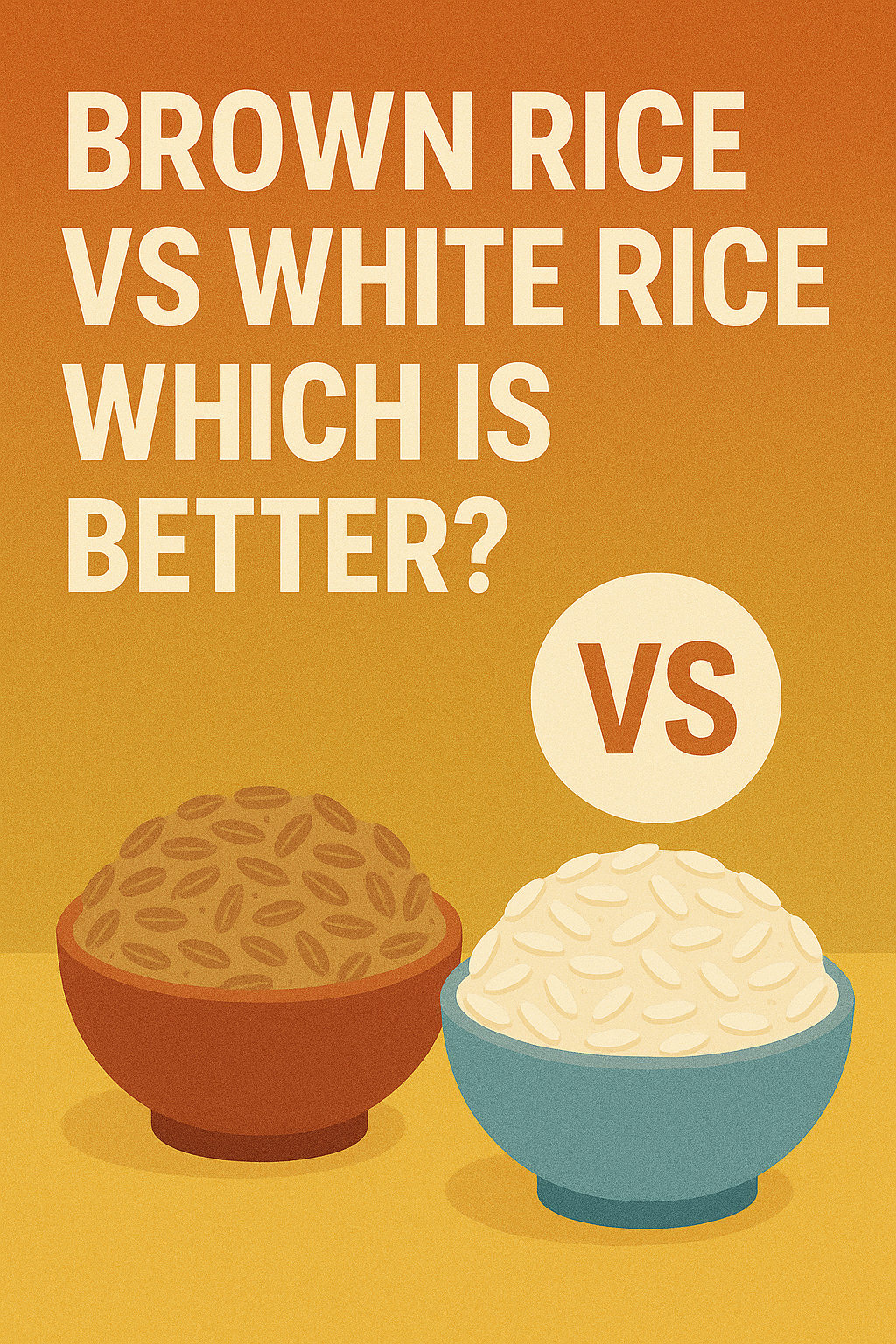Introduction
Rice is a staple food in many cultures around the world, providing a significant source of carbohydrates, fiber, and nutrients. With so many types of rice available, choosing the right one can be overwhelming, especially when it comes to deciding between brown rice and white rice.
Both types of rice have their own unique characteristics, nutritional profiles, and potential health benefits.
In this article, we’ll compare and contrast brown rice and white rice, exploring their nutritional differences, health benefits, and potential drawbacks. By the end of this article, you’ll have a better understanding of which type of rice is best for your individual needs and preferences.
Nutrition Comparison
When it comes to nutrition, brown rice and white rice have distinct differences. Here’s a breakdown of their nutritional content:
Brown Rice
Fiber content: Brown rice is a good source of dietary fiber, containing about 3.5 grams per 1 cup cooked.
Protein content: Brown rice contains about 5 grams of protein per 1 cup cooked.
Mineral content: Brown rice is a good source of minerals like manganese, selenium, and magnesium.
Antioxidant content: Brown rice contains antioxidants like phenolic acids and lignans.
White Rice
Fiber content: White rice is relatively low in fiber, containing about 0.6 grams per 1 cup cooked.
Protein content: White rice contains about 4 grams of protein per 1 cup cooked.
Mineral content: White rice is often enriched with iron, thiamin, niacin, and folic acid.
Antioxidant content: White rice contains fewer antioxidants compared to brown rice.
Key Differences
The main differences between brown rice and white rice are:
Fiber content: Brown rice contains significantly more fiber than white rice.
Mineral content: Brown rice is a better source of minerals like manganese and selenium.
Antioxidant content: Brown rice contains more antioxidants than white rice.
These nutritional differences can have a significant impact on our health, which we’ll explore in the next sections.
Health Benefits of Brown Rice
Brown rice has been associated with several potential health benefits, including:
Lower Risk of Heart Disease
Cholesterol reduction: The fiber and antioxidants in brown rice may help lower cholesterol levels, reducing the risk of heart disease.
Blood pressure management: The potassium content in brown rice may help manage blood pressure, further reducing the risk of heart disease.
Improved Blood Sugar Control
Slower digestion: The fiber in brown rice can slow down digestion, reducing the spike in blood sugar levels after a meal.
Improved insulin sensitivity: The antioxidants and fiber in brown rice may help improve insulin sensitivity, reducing the risk of developing type 2 diabetes.
Increased Satiety and Weight Loss
Fiber content: The fiber in brown rice can help promote feelings of fullness and satiety, leading to weight loss.
Slower digestion: The slower digestion rate of brown rice can also help reduce hunger and increase feelings of fullness.
Other Potential Benefits
Cancer prevention: The antioxidants and fiber in brown rice may help reduce the risk of certain types of cancer.
Improved gut health: The fiber in brown rice can help promote the growth of beneficial gut bacteria.
These potential health benefits make brown rice a nutritious and healthy addition to a balanced diet.
Health Benefits of White Rice
While brown rice is often considered the healthier option, white rice also has its own set of benefits, particularly in certain situations:
Providing Quick Energy
Rapid digestion: White rice is quickly digested, making it a good source of rapid energy for athletes or individuals with high energy needs.
Easy to consume: White rice is often easier to consume, especially for those with digestive issues or sensitive stomachs.
Easier to Digest
Lower fiber content: White rice has a lower fiber content compared to brown rice, making it easier to digest for individuals with certain gastrointestinal issues.
Less discomfort: White rice may cause less discomfort and bloating compared to brown rice, especially for those with irritable bowel syndrome (IBS).
Other Potential Benefits
Fortified with nutrients: White rice is often enriched with iron, thiamin, niacin, and folic acid, making it a good source of these essential nutrients.
Cultural significance: White rice is a staple food in many cultures, providing a sense of comfort and familiarity.
When White Rice May Be Preferred
Athletes or high-energy individuals: White rice may be preferred for athletes or individuals with high energy needs due to its rapid digestion and energy provision.
Individuals with digestive issues: White rice may be easier to digest for individuals with certain gastrointestinal issues, such as IBS or Crohn’s disease.
While white rice may not have the same nutritional profile as brown rice, it still has its own set of benefits and can be a part of a healthy diet in certain situations.
Glycemic Index and Blood Sugar Control
The glycemic index (GI) is a measure of how quickly a food raises blood sugar levels. Both brown rice and white rice can affect blood sugar control, but they differ in terms of their GI:
Glycemic Index of Brown Rice and White Rice
Brown rice: Brown rice has a lower GI compared to white rice, with a GI of around 50.
White rice: White rice has a higher GI, with a GI of around 70-80.
Impact on Blood Sugar Control
Brown rice: The lower GI of brown rice means it may help regulate blood sugar levels and improve insulin sensitivity.
White rice: The higher GI of white rice means it may cause a more rapid spike in blood sugar levels, potentially leading to insulin resistance and other health issues.
Factors Affecting Glycemic Index
Type of rice: The type of rice, including the variety and processing method, can affect its GI.
Cooking method: The cooking method, including the amount of water used and cooking time, can also impact the GI of rice.
Choosing the Right Rice for Blood Sugar Control
Brown rice: Brown rice may be a better choice for individuals with diabetes or those trying to manage their blood sugar levels.
White rice: White rice may be more suitable for athletes or individuals with high energy needs, but it’s essential to consume it in moderation and balance it with other nutrient-dense foods.
Conclusion
In conclusion, both brown rice and white rice have their own unique characteristics, nutritional profiles, and potential health benefits. Brown rice is generally considered the healthier option due to its higher fiber and nutrient content, while white rice is often preferred for its ease of digestion and rapid energy provision.
Choosing the Right Rice for Your Needs
Brown rice: Brown rice may be a better choice for individuals looking for a more nutritious and filling option, particularly those with diabetes or trying to manage their blood sugar levels.
White rice: White rice may be more suitable for athletes or individuals with high energy needs, or those with digestive issues who require an easily digestible carbohydrate source.
Key Takeaways
Nutritional differences: Brown rice and white rice differ significantly in terms of their nutritional content, with brown rice being higher in fiber and nutrients.
Health benefits: Both types of rice have potential health benefits, including improved blood sugar control and increased satiety.
Glycemic index: The glycemic index of brown rice and white rice differs, with brown rice having a lower GI and white rice having a higher GI.
Final Thoughts
Ultimately, the choice between brown rice and white rice depends on individual needs and preferences. By understanding the nutritional differences and potential health benefits of each type of rice, you can make informed decisions about which type of rice to include in your diet.




